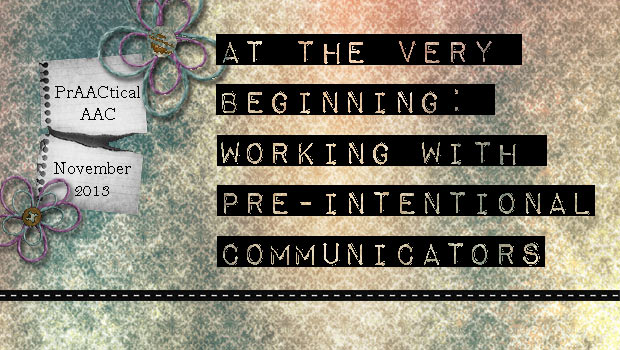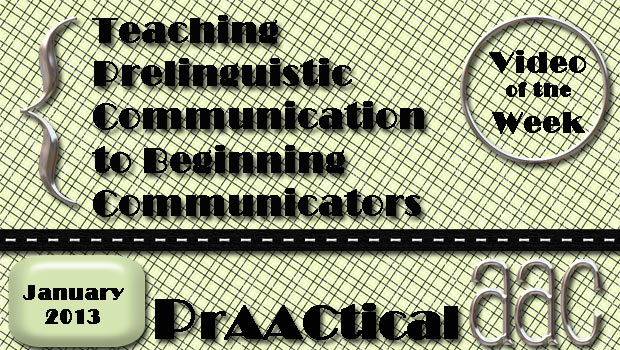At the Very Beginning: Working with Pre-Intentional Communicators

Recently, I had the opportunity to work with a first grader who was able to do many things: flash a dazzling smile, grab and hold onto materials on his laptray, vocalize loudly, visually track peers as they moved around the classroom, reach and take a toy that was offered to him, and laugh in such an engaging way that two girls immediately went to his side. What he DIDN’T do, though, was communicate purposefully.
How do you address the learning needs of a 7-year-old who is not yet communicating with intent? Here are some initial thoughts.
Getting him to learn to communicate purposefully, frequently, and in a way that is obvious (not subtle) is Priority #1. The way we typically approach this is to work with the team (teacher, OT, PT, aide, family) to decide on a motor movement that he can do, and agree to shape that into a purposeful signal. For example, if he is able to move his arm, that might be a good place to start. This becomes “The Signal.” Input from others who know him well is the key here. What kinds of signals are best? The ones that:
- the learner already does, but not necessarily as a means of communication
- are observable
- have high inter-rater reliability (we all agree on what we’re seeing)
- are relatively easy for him to produce (i.e., don’t cause a lot of fatigue)
- If possible, it speeds things up to select a behavior that can be physically prompted (e.g., arm movement, tapping, leaning forward), as opposed to things like vocalization or eye gaze.
Once we’ve decided what to focus on as “The Signal,” then the next step is to think about what kinds of things are more motivating to the learner than others. For example, if he likes attention, then you might engage him in social exchanges or interaction games (think: Peek a Boo, but in an age appropriate way). In the middle of the game/exchange (just when he’s really having fun), stop and pause, waiting for him to exhibit that signal. As soon as he does, we spring into action, acting as if the learner said ‘more’ and quickly re-start the fun activity.
In our experience, there are 3 tricks to making this work. One is to be sure everyone is looking for/at the same signal (e.g., moving right arm) and recognizes it as “The Signal.” The second is providing dozens of opportunities throughout the day for these kinds of exchanges. The third is to be sure that the learner gets the reinforcement immediately after exhibiting the signal. That is what it generally takes for pre-intentional communicators to become intentional communicators. This process will help the learner make the connection that doing a certain thing (“The Signal”) gets them something positive.
Helping someone cross the bridge into the world of intentional communication, takes patience and repetition, but is as worthwhile a venture as you’ll ever experience. It’s a pretty simple formula:
- Take a single signal (observable, something the learner already does, easy to prompt); “The Signal”
- Identify a variety of different activities that are enjoyable for the learner
- Engage the learner in fun exchanges, then stop and pause
- Wait and watch for “The Signal”
- As soon as you see it (or something close to it), quickly re-start the fun interaction.
- Repeat with more fun activities as often as you can.
You can learn about this and Prelinguistic Milieu Teaching, a more formal way to address the needs of these learners, here.
Filed under: PrAACtical Thinking
Tagged With: PMT, preintentional, prelinguistic
This post was written by Carole Zangari

